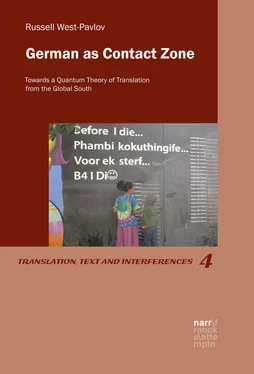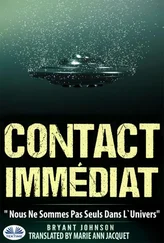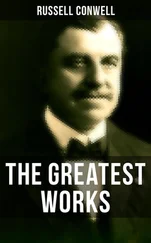What I am proposing, via my inaugural but patently decentred reading of Rostov-Luanda that focuses upon the almost complete absence of its elided third term (Berlin), is the centrifugal displacement—the expatriation—of German and Germany itself. The film is all about language, but at the end, language becomes mute, and takes its naturally subordinate place within the material world that is the other major subject of Sissako’s filmic gaze. This shift of emphasis does not merely work to alienate and denaturalize human language—but rather, in the final analysis, to renaturalize it and to place it in networks of productive translation. Such networks of renaturalized translation are inevitably obfuscated, tamped down and controlled by the nation state and its attendant national languages in the first instance, and by extension all language that is conceptualized as the marker par excellence of the human. The post- and dehumanization of language leads ineluctably towards the re-naturalization of language as translation within a larger framework of universal translation.
This book is divided into three parts: one part devoted to ‘theory’ and two parts devoted to respective versions of ‘application’: the first in the area of literary interpretations, the second in the area of teaching methodologies. In fact, as will become evident as the reader progresses through the book, none of these parts really fulfils this idealized hypostatization of ‘theory’ and ‘practice’ respectively; and even ‘practice’ falls into very different forms of ‘doing’ literary or cultural studies. All three parts are in fact hybrid undertakings, intertwined with each other. Each section thus constitutes a ‘trading zone’ between theory and experimentation (Galison 1999) that in many ways is structurally analogous to the ‘contact zones’ that are everywhere explored—and performatively opened up and populated—in the book. Thus the theoretical sections of the book make no claim to exhaustive documentation or neutral scholarship. They are in reality a polemical and essayistic exploration of the intuition that apparently separate activities such as ‘translation’ and the ‘material reality of the world’ are in fact very close to one another in their underlying dynamic. They therefore seek to translate ‘translation’ into the foreign semantic field of quantum theory. In these chapters, translation becomes ‘quantized’. This section of the book is iconoclastic rather than soberly scholarly in its tenor, seeking to infringe consecrated boundaries both in form and content. Likewise, the second part of the book, which proceeds to case studies of individual translations, aims to ask about the ways in which the German language, as a source or target language of literary translation, can be seen to become ‘quantized’ or to ‘quantize’ itself within the translation process. Thus the translation of language, no less than the language of translation, also finds itself ‘translated’ into the bizarre world of quantum gravity processes. The third part of this book re-translates this translation of translation into the world of the classroom, a place of interactions and exchanges that microcosmically maps the larger social world and perhaps, as I will suggest, the natural world as well.
Thus, to summarize again, in the chapters that make up part 1 of this book I lay down the lineaments of a theory of quantum translation according to which a quantized German would function as a ‘contact zone’ at the interface with other languages and cultures. In part 2 of the book I explore what this notion of quantum translation might look like once translated into a translative practice in which German is the source language (Sebald, Hölderlin) or the target language (Mujila)—or in one case, both at once (Eich/Vladislavić). In part 3, I turn to a further ‘translation’ of ‘translation’, that of the transposition of translation into the classroom.
Part 1 opens with a chapter devoted to the exemplary moment of the ‘translative turn’ in cultural studies and suggests that this moment may be scaled up to prise open the closed box of interlingual translation ‘proper’. The cultural turn in translation studies, which had hitherto been a largely technical and instrumentalist discipline, was followed by a translative turn in cultural studies. These incremental shifts away from a narrow notion of translation as an exclusively linguistic notion of semantic transfer between natural or even national languages were registered with increasing disapproval by the guardians of disciplinary purity. Chapter 1 exploits that moment of resistance as a heuristic device to interrogate the very notion of a translational border and point to possible ways of overcoming it in an even more radical manner.
Following this inaugural gesture, chapters 2 and 3 orchestrate a contractive movement that suggest that human language is actually only a very minor part of the larger cosmic business of the exchange of information. Here, I examine anthropological theories by Kohn, Viveiros de Castro and Ingold. Chapter 2 addresses Kohn’s anthropological notion of ‘provincializing language’ and demonstrates the limitations, but also the necessity of a fundamental paradigm shift within the anthropological sciences. There, the anthropologist is a translator who can only with great difficulty abandon his position as the adjudicator of language as the marker of humanity. In chapter 3 I turn to the work of Viveiros de Castro and Ingold for more generous versions of the anthropological translator. Here, the translator as shaman is better equipped to open language up to a broad and inclusive community of nonhuman actants. The translator-shaman does not translate between cultures as the translator-anthropologist does, but rather, translates the multiplicity of the heart of all things, whether human or non-human, cultural or natural. The shaman presides over local nodes of a universal process of translation. Indeed, language itself registers this universal transformation, in Tim Ingold’s notion of the verbs that describe beings in the circumpolar world, by becoming a ‘languaging’—language permanently in a state of translation because it is part of a world-in-translation.
Following these preparatory moves, in chapter 4 I rehearse a contrary expansive movement that elevates translation from a restricted linguistic operation to a universal operator of information exchange. I call upon the work of Michel Serres and Juri Lotman to explore these ideas. Serres treats a wide range of intellectual practices across the natural and human sciences as practices of translation. What they all have in common is that they identify and formalize exchanges of information. Translation as the exchange of information is the underlying operation that can be found everywhere in the cosmos, and the production of invariability via variation is its leitmotif. Serres’ approach to translation is an all-embracing one that includes Lotman’s notion of translation as a basic cognitive operation. Because Serres reads all exchanges in the natural world as exchanges of information, cognition spills across the border from the human world of culture into the nonhuman world.
Building upon the double, countervailing movements of chapters 2, 3 and 4, a third moment in the argument (chapter 5) uses the same double scaling of great and small to introduce a quantum theory of translation. The chapter suggests that such a theory would stress that the linguistic process of translation is part and parcel of all the processes that quantum-gravity theory deals with, from the very precisely identifiable mega-nano-dimension of the basic building blocks of gravitational quanta upwards. Proceeding from the generative nature of all cosmic processes constructed out of quantum-gravity attractive pulls, a quantum theory of translation would also emphasize the non-linear, ‘probabilistic’ character of translation. Radicalizing Quine’s ‘indeterminacy thesis’ and the work of Berman on the creativity of translation, the chapter harnesses the quantum theory of translation to show how translation produces new versions of reality in the multilingual borderlands between specific local semiospheres.
Читать дальше












